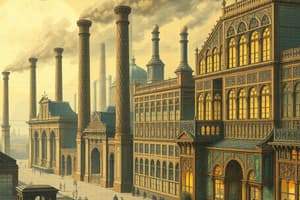Podcast
Questions and Answers
What was the population of Greater Manchester in 1801?
What was the population of Greater Manchester in 1801?
- Over 100,000
- Over 300,000 (correct)
- Around 50,000
- Less than 10,000
What was the population of London in 1851?
What was the population of London in 1851?
- Over 6,000,000
- Around 5,000,000 (correct)
- Less than 2,000,000
- Around 3,000,000
What was a significant reason for people migrating to towns during the industrial revolution?
What was a significant reason for people migrating to towns during the industrial revolution?
- Abundance of natural resources in urban areas
- Availability of better healthcare facilities
- Higher wages offered by factories (correct)
- Lower cost of living compared to rural areas
Why were factories not required to be located near rivers during the industrial revolution?
Why were factories not required to be located near rivers during the industrial revolution?
What was the housing condition for the workforce near the factories?
What was the housing condition for the workforce near the factories?
What was the common feature of the housing layout near factories?
What was the common feature of the housing layout near factories?
What were the living conditions like in the cramped houses near the factories?
What were the living conditions like in the cramped houses near the factories?
What was the primary source of heating in the cramped houses near the factories?
What was the primary source of heating in the cramped houses near the factories?
What was the impact of overcrowded housing near factories?
What was the impact of overcrowded housing near factories?
What were the conditions of the privies near the cramped houses?
What were the conditions of the privies near the cramped houses?
What was the average life expectancy of poor children living in Manchester in 1840?
What was the average life expectancy of poor children living in Manchester in 1840?
What was the life expectancy of a factory worker in Liverpool in 1840?
What was the life expectancy of a factory worker in Liverpool in 1840?
What was the crucial achievement of Joseph Bazalgette in the 1870s?
What was the crucial achievement of Joseph Bazalgette in the 1870s?
What did the 1875 Public Health Act require for all new accommodation?
What did the 1875 Public Health Act require for all new accommodation?
What did the Artisans’ and Labourers’ Dwellings Act of 1875 empower local authorities to do?
What did the Artisans’ and Labourers’ Dwellings Act of 1875 empower local authorities to do?
What did George Peabody, an American businessman, build for the poor?
What did George Peabody, an American businessman, build for the poor?
What was the role of the Sanitary Authorities established in 1872?
What was the role of the Sanitary Authorities established in 1872?
What was the primary cause of disease spread among the urban poor in the 19th century?
What was the primary cause of disease spread among the urban poor in the 19th century?
What was the main characteristic of the living conditions of the poorest in industrial towns?
What was the main characteristic of the living conditions of the poorest in industrial towns?
What did the rapid growth of towns in the 19th century lead to a lack of?
What did the rapid growth of towns in the 19th century lead to a lack of?
Flashcards are hidden until you start studying
Study Notes
Population and Urbanization
- In 1801, the population of Greater Manchester was approximately 328,000.
- By 1851, the population of London had grown to around 2.4 million.
Industrial Revolution and Migration
- A significant reason for people migrating to towns during the industrial revolution was the availability of jobs in factories.
Factory Location and Housing
- Factories were not required to be located near rivers during the industrial revolution due to the development of steam power.
- Housing conditions for the workforce near the factories were overcrowded and unsanitary.
- The common feature of the housing layout near factories was Back-to-Back houses, which were poorly ventilated and lacked basic amenities.
Living Conditions and Health
- Living conditions in the cramped houses near the factories were characterized by overcrowding, poor ventilation, and lack of sanitation.
- The primary source of heating in these houses was coal fires.
- Overcrowded housing near factories led to the rapid spread of diseases.
- Privies near the cramped houses were often overflowing and unsanitary, contributing to the spread of diseases.
- In 1840, the average life expectancy of poor children living in Manchester was around 17 years.
- The life expectancy of a factory worker in Liverpool in 1840 was around 26 years.
Public Health Reforms
- Joseph Bazalgette's crucial achievement in the 1870s was the design of a modern sewage system for London.
- The 1875 Public Health Act required all new accommodation to have a proper drainage system.
- The Artisans' and Labourers' Dwellings Act of 1875 empowered local authorities to demolish and redevelop slum areas.
- George Peabody, an American businessman, built affordable housing for the poor.
- The Sanitary Authorities established in 1872 were responsible for monitoring and improving public health conditions.
Urban Health Issues
- The primary cause of disease spread among the urban poor in the 19th century was poor sanitation and living conditions.
- The main characteristic of the living conditions of the poorest in industrial towns was overcrowding and lack of basic amenities.
- The rapid growth of towns in the 19th century led to a lack of adequate housing, sanitation, and healthcare services.
Studying That Suits You
Use AI to generate personalized quizzes and flashcards to suit your learning preferences.




